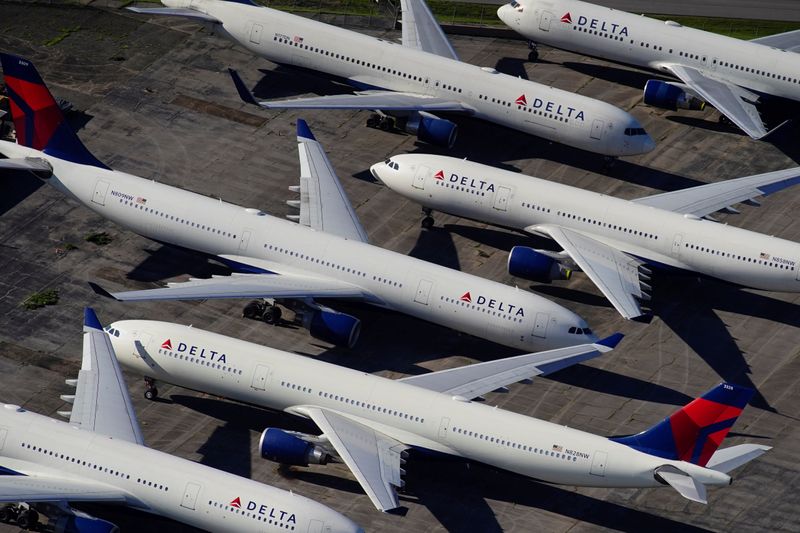By Reade Levinson
LONDON (Reuters) - As the novel coronavirus continues to spread, commercial flights have all but stopped. The situation is so dire that the head of the trade group representing the world's airlines called the last few months "its deepest crisis ever."
A Reuters analysis of data from FlightAware, which tracks air traffic in real-time, reveals a series of sequential and precipitous declines in flights in four key regions as officials sought to contain the outbreak.
From March 24 to March 30, FlightAware tracked about 280,000 flights, down almost 500,000 from the same week a year earlier.
In late March, the International Air Transport Association estimated lost revenue from the coronavirus will exceed $250 billion in 2020 and urged governments to offer immediate financial support to the industry.
The transport association said today's crisis is far worse and more widespread than after 9/11, when U.S. airlines lost approximately $19.6 billion in revenue in 2001-2002. After the terrorist attacks, the U.S. government provided $15 billion to airlines in compensation and loan guarantees.
"Airlines are desperately trying to survive in the most difficult times imaginable," said Alexandre de Juniac, head of the IATA. "We have the people and the experience to see this through. But, to be perfectly frank, we don’t have the money."
Congress voted on March 27 to give the U.S. aviation industry $58 billion in a coronavirus rescue package, and Singapore Airlines lined up a $13 billion funding package led by state investor and majority stakeholder Temasek.
GRAPHIC: The toll on travel - https://graphics.reuters.com/HEALTH-CORONAVIRUS/FLIGHTS/qzjvqeqrvxm/index.html
AIRLINES LIMIT FLIGHTS
Because of travel restrictions enacted by governments around the world, the number of airlines grounding most or all of their fleets has grown rapidly over the past few weeks.
To account for day-to-day changes in the number of flights on weekends versus weekdays, Reuters measured change in air travel based on the same day a year prior.
In the Middle East, major carriers including Emirates, Flydubai and Saudia, Saudi Arabia's state airline, suspended all passenger flights. Israel's El Al slashed its flight schedule, and Turkish Airlines suspended all international flights on March 27.
In Asia, Singapore Airlines grounded most of its fleet on March 23 after the city-state banned all short-term visitors, and Qantas suspended international flights until at least May after the Australian government banned the arrival of non-citizens and non-residents.
In Europe, passenger data from the region's Airports Council International reveals an even deeper industry crisis than air traffic statistics indicate. As of March 22, the number of passengers traveling into and out of European airports had declined by 88%, or 5.2 million fewer daily travelers compared to a year earlier.
In Italy, containment efforts to staunch the spread of the virus triggered a rapid drop. There, data shows a 98% decline in passenger travel, or 440,000 fewer daily passengers compared to the same time last year.
Budget airlines Ryanair and easyJet (LON:EZJ) grounded most of their fleets in late March.
U.K. CLOSES WINDOW
The number of passengers arriving to and departing from British airports has also declined, though at a slower pace than elsewhere in Europe. As of March 22, data shows passenger traffic down 82% from the same time last year.
One reason for the difference: The UK was originally exempt from the U.S. travel ban on foreign nationals who had recently visited China, Iran and a group of 14 European countries, said Michael Stanton-Geddes, head of economics at ACI-Europe.
The exemption "temporarily protected a lot of transatlantic traffic," he said. "People getting from Europe to the U.S. had to go through London."
As of mid-March, some vacationers were still leaving the UK for European destinations. On March 14, Jet2 turned around flights bound for Spain after the airline canceled all flights to the mainland.
In China, air traffic is starting to pick back up after two months of severe travel restrictions. The country saw a half million fewer flights during the same two-month period compared to the same period a year ago.
A TURBULENT TIME
The drop in flights in the United States following the Trump administration's travel restrictions mirrors the drop in air traffic around the world.
Data from FlightAware shows just 866 international flights arrived in or departed from the United States on March 30, a drop of 83% compared to the same day a year ago. Flights involving private business jets and turboprop planes were also down 67% in the U.S. and 64% worldwide, the data shows.
The number of domestic flights has been less affected than international flights, however. Daily flights within the United States were down 51% on Monday compared to a year prior, according to FlightAware data.
But many of those flights have far fewer passengers. Planes are only 10-20% full, industry lobby Airlines for America said in late March.
CARGO SUPPLANTS PASSENGERS
So far, the number of cargo flights has remained largely unaffected by the travel restrictions.
Data from FlightAware shows flights by freight and package carriers such as Atlas, Polar, FedEx (NYSE:FDX) and UPS arriving in and departing from the United States initially declined during the first week of February 2020. The drop, which correlated to the Hubei Province lockdown, "shows how important China is to the world of international commerce," said Andrew Charlton, an industry analyst.
Shortly thereafter, however, U.S. cargo flights rebounded to previous levels, the data shows.

Because passenger jets transport about half of all air cargo carried worldwide, the grounding of those planes has increased demand for freighters. In response, some commercial airlines such as American, Delta and Virgin Atlantic are using passenger jets solely for shipping cargo.